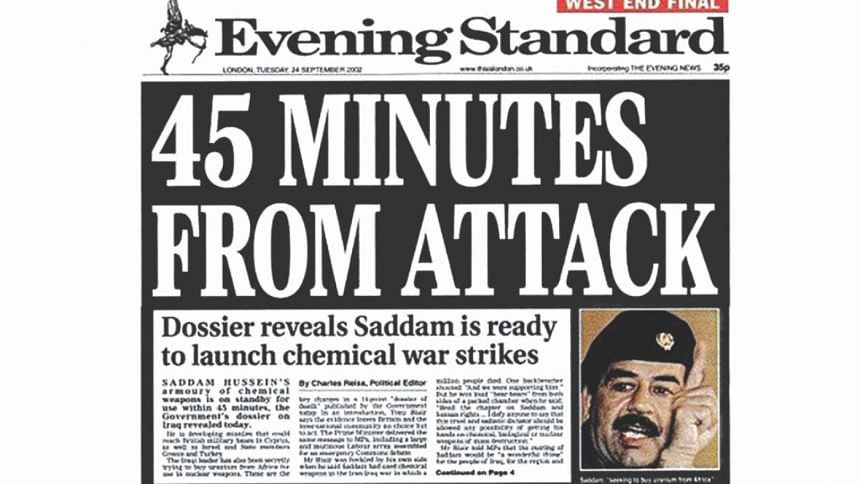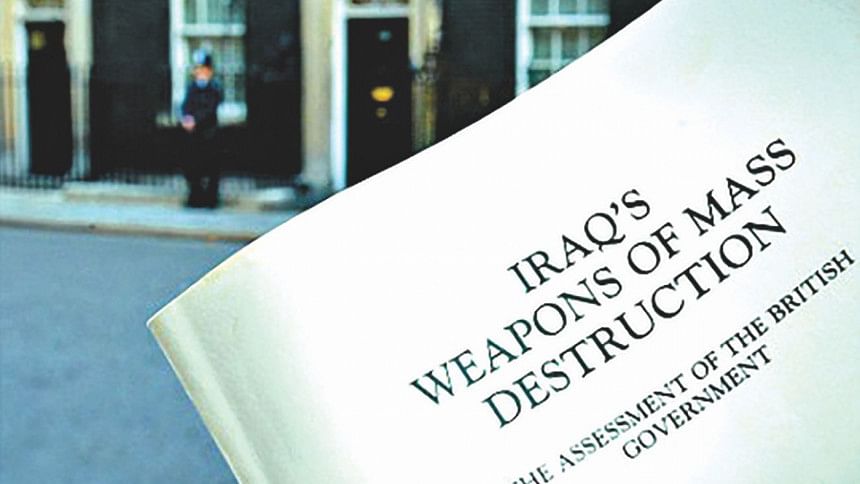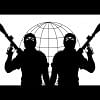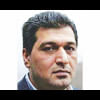A war for oil #6: Of a taxi driver and Iraq invasion

The biggest 'proof' that Saddam Hussein possessed WMD was a document called '45 minutes from doom' prepared by the UK. Tony Blair convinced his parliament to attack Iraq based on this dossier. Sadly, it was based on hearsay and the description of a taxi driver.
"45 minutes from doom", the most significant dossier that Tony Blair produced to convince his country that Saddam Hussein actually possessed WMD and that he could hit British mainland within 45 minutes of an order, was completely false.
Not only that, the source of the information of the 50-page dossier, that Blair touted as a hard evidence of Saddam's WMD, is thought to have come from an Iraqi taxi driver. Not only that, a complete section of the dossier was actually picked from the doctoral paper of a California State University student.
Later on February 7, 2003, Downing Street apologized for the failure to acknowledge that much of the dossier was plagiarized from the university student's paper. It was later found out the plagiarism was done by mid-level officials in Blair's communication chief Alastair Campbell's Downing Street office.
However, Blair convinced the House of Commons with this dossier that invasion of Iraq was a must. The media was misled to sensationalise Blair's "revelation" with headlines like "Missiles fly in 45 minutes" by The Times of London, and "Brits 45 mins from doom" by The Sun.
This is the document that finally helped Blair and Bush to invade Iraq. And this is the document that later became the centre of the heated accusations against Blair that he had "sexed up" the
WMD report.
The subsequent whole range of events include resignation of BBC's top bosses who first challenged the authenticity of the report to the suicide of Dr David Kelly, a British biological warfare expert who first doubted the authenticity of the dossier.
The dossier referred to by The Guardian as a "journalistic cut-and-paste job rather than a high-grade intelligence analysis" became the centre of attention by the media worldwide as US secretary of state Colin Powell used it as a centre point of his address in the UN Security Council in February 5, 2003 to gather support for Iraq invasion.
The analysis of the dossier and its origin is important because it shows how the British intelligence dropped all caution in picking its intelligence and how callously it failed to check on any information and source.
But the most shameful fact is that the dossier was "sexed up" to give it an authentic and authoritative feel at 10 Downing Street, the office of the British prime minister, by Tony Blair himself along with Jack Straw and his chief spin doctor Alastair Campbell.
Today in hindsight, one may suspect any intelligence report that the US or UK produces that serves to meet their own goal.
HOW THE 45-MINUTE REPORT ORIGINATED
Downing Street ordered the Joint Intelligence Committee (JIC) to prepare a paper in February of 2002 on "WMD countries of concern" mainly North Korea, Iran, Libya and Iraq ahead of a planned meeting between Blair and Bush that April, the Chilcot report reveals.
The dossier was "designed to make the case and secure Parliamentary and public support for the government's position" that urgent action was needed, Sir Chilcot in his report said.
Jack Straw first had a look at the first draft on March 8 and was disappointed as it didn't put enough emphasis on Iraq.
He said: "Good, but should not Iraq be FIRST and also have more text?
"The paper has to show why there is an EXCEPTIONAL threat from Iraq. It does not quite do this yet".
So, On March 18 he decided a special paper just on Iraq should be prepared. But on March 22, publication of this paper was postponed after "Mr. Straw was advised that the evidence would not convince public opinion that there was an imminent threat from Iraq," the Chilcot report said.
Downing Street then decided to coordinate a "public dossier" on Iraq, which turned into the "45 minutes to doom" September 2002 dossier.

HOW 45-MIN REPORT INFORMATION WAS GATHERED
There are two stories about who the source of the report was that ultimately became the cornerstone for Iraq invasion.
The most damning claim is that it came from an Iraqi taxi driver. The other story is it came from a mid-ranking Iraqi military officer.
Whatever the source, it was much after the war that it was deemed unreliable and the information complete lie as no WMD was found.
Adam Holloway, a defence specialist and a member of the Commons Defence Committee, said in a committee report on December 8, 2009 that the British intelligence MI6 had obtained information indirectly from a taxi driver who had overheard two Iraqi military commanders talking about Saddam's weapons.
"In the end it turned out that the information was not credible, it had originated from an émigré taxi driver on the Iraqi-Jordanian border, who had remembered an overheard a conversation in the back of his cab a full two years earlier," The defence committee report said.
But six years before Holloway's disclosure, an investigation by Lord Brian Hutton found that the WMD claim came from Lt Col al-Dabbagh, the son-in-law of a retired Iraqi brigadier general.
The Telegraph later was able to trace Dabbagh, a man full of braggadocio, and his version of how he came to know the existence of the WMD sounded completely hollow.
"Saddam's people are doing this all the time," he told The Telegraph reporter in December 2003. "That is why it is so difficult to find the weapons of mass destruction. I am sure the weapons are hidden in Iraq just like I see you know."
Dabbagh was dismissed from service after the war. Asked why he was dismissed, he gave the comical reply: "I don't know why they did this to me. My name was passed to the US six months before the war as someone who was helping them."
How unreliable Dabbagh was as a source was revealed by The Washington Post which contacted him in February 2004. Dabbagh showed the Post reporter a tracing-paper map on which he had drawn what he claimed were air defence installations and deployments of unconventional weapons in the western Iraqi desert.
"The 45 minutes, it's from me," he bragged.
However, Dabbagh as the source of the claim was proven false when the Commons Defence Committee report by Holloway came to light.
WHAT THE 45-MIN REPORT SAID
So, based on such unverifiable and unreliable sources and hearsays, the infamous dossier, made public on September 24, said Saddam Hussein's chemical weapons are on standby for use within 45 minutes.
It said, the Iraqi leader has 20 missiles which could reach British military bases in Cyprus, as well as Israel and Nato members Greece and Turkey. He has also been seeking to buy uranium from Africa for use in nuclear weapons.
In the foreword to the dossier, Tony Blair justified the Iraq invasion by saying, "The document discloses that his military planning allows for some of the WMDs to be ready within 45 minutes of an order to use them."
So Blair and Bush pushed forward based on this report to invade Iraq. With his fiery oratory power, Blair convinced his people that Iraq posed a clear and present danger and future threat and that Saddam must be eliminated.
But six years down the line, Adam Holloway's defence committee report revealed how Downing Street had sexed up the dodgy dossier with the insertion of the misleading claim that Saddam had been poised to launch WMD.
The Lord Hutton inquiry in 2004 maintained important cautions about the lacking of the intelligence information had been removed from the dossier.
The defence committee report also corroborated the Hutton inquiry findings and claimed MI6 had reservations about some of the information in the dossier but its views were brushed aside by Downing Street.
"Under pressure from Downing Street to find anything to back up the WMD case, British intelligence was squeezing their agents in Iraq for information. One agent did come up with something: the '45 minutes' or something about missiles allegedly discussed in a high level Iraqi political meeting.
"But the provenance of this information was never questioned in detail until after the Iraq invasion, when it became apparent that something was wrong. In the end it turned out that the information was not credible, it had originated from an émigré taxi driver on the Iraqi-Jordanian border, who had remembered an overheard conversation in the back of his cab a full two years earlier," the defence committee said.
"Indeed, in the intelligence analyst's footnote to the report, it was flagged up that part of the report probably describing some missiles that the Iraqi government allegedly possessed was demonstrably untrue. They verifiably did not exist.
"The footnote said it in black and white ink. Despite this glaring factual inaccuracy, which under normal circumstances would have caused the reliability of the intelligence to be seriously questioned, the report was treated as reliable and went on to become one of the central planks of the dodgy dossier," the defence committee report concluded.
After the invasion another inquiry headed by Lord Butler in 2004 also said the 45-minute claim should never have been included because it fell on the "outer limits of the intelligence available".
He also found the intelligence available was "insufficiently robust" to prove Iraq was in breach of the United Nations' resolutions.
He also said the sources were highly doubtful and some of the human intelligence about Iraq's weapons of mass destruction were "seriously flawed" and "open to doubt".
In his view, the Joint Intelligence Committee should not have included the "45 minute" claim in the dossier without stating what exactly it referred to.

 For all latest news, follow The Daily Star's Google News channel.
For all latest news, follow The Daily Star's Google News channel. 








Comments